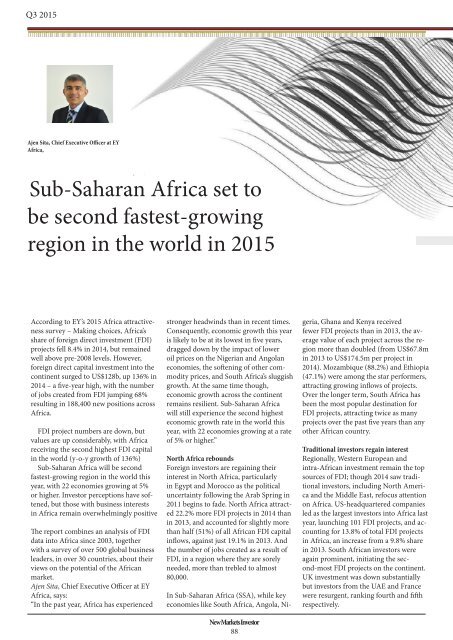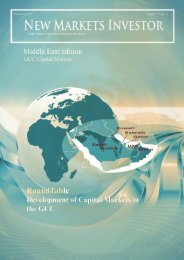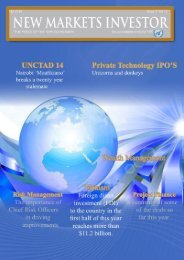New Markets Investor
Published by The Media Corporation
Published by The Media Corporation
You also want an ePaper? Increase the reach of your titles
YUMPU automatically turns print PDFs into web optimized ePapers that Google loves.
Q3 2015Ajen Sita, Chief Executive Officer at EYAfrica,Sub-Saharan Africa set tobe second fastest-growingregion in the world in 2015According to EY’s 2015 Africa attractivenesssurvey – Making choices, Africa’sshare of foreign direct investment (FDI)projects fell 8.4% in 2014, but remainedwell above pre-2008 levels. However,foreign direct capital investment into thecontinent surged to US$128b, up 136% in2014 – a five-year high, with the numberof jobs created from FDI jumping 68%resulting in 188,400 new positions acrossAfrica.FDI project numbers are down, butvalues are up considerably, with Africareceiving the second highest FDI capitalin the world (y-o-y growth of 136%)Sub-Saharan Africa will be secondfastest-growing region in the world thisyear, with 22 economies growing at 5%or higher. <strong>Investor</strong> perceptions have softened,but those with business interestsin Africa remain overwhelmingly positiveThe report combines an analysis of FDIdata into Africa since 2003, togetherwith a survey of over 500 global businessleaders, in over 30 countries, about theirviews on the potential of the Africanmarket.Ajen Sita, Chief Executive Officer at EYAfrica, says:“In the past year, Africa has experiencedstronger headwinds than in recent times.Consequently, economic growth this yearis likely to be at its lowest in five years,dragged down by the impact of loweroil prices on the Nigerian and Angolaneconomies, the softening of other commodityprices, and South Africa’s sluggishgrowth. At the same time though,economic growth across the continentremains resilient. Sub-Saharan Africawill still experience the second highesteconomic growth rate in the world thisyear, with 22 economies growing at a rateof 5% or higher.”North Africa reboundsForeign investors are regaining theirinterest in North Africa, particularlyin Egypt and Morocco as the politicaluncertainty following the Arab Spring in2011 begins to fade. North Africa attracted22.2% more FDI projects in 2014 thanin 2013, and accounted for slightly morethan half (51%) of all African FDI capitalinflows, against just 19.1% in 2013. Andthe number of jobs created as a result ofFDI, in a region where they are sorelyneeded, more than trebled to almost80,000.<strong>New</strong> <strong>Markets</strong> <strong>Investor</strong>88In Sub-Saharan Africa (SSA), while keyeconomies like South Africa, Angola, Nigeria,Ghana and Kenya receivedfewer FDI projects than in 2013, the averagevalue of each project across the regionmore than doubled (from US$67.8min 2013 to US$174.5m per project in2014). Mozambique (88.2%) and Ethiopia(47.1%) were among the star performers,attracting growing inflows of projects.Over the longer term, South Africa hasbeen the most popular destination forFDI projects, attracting twice as manyprojects over the past five years than anyother African country.Traditional investors regain interestRegionally, Western European andintra-African investment remain the topsources of FDI; though 2014 saw traditionalinvestors, including North Americaand the Middle East, refocus attentionon Africa. US-headquartered companiesled as the largest investors into Africa lastyear, launching 101 FDI projects, and accountingfor 13.8% of total FDI projectsin Africa, an increase from a 9.8% sharein 2013. South African investors wereagain prominent, initiating the second-mostFDI projects on the continent.UK investment was down substantiallybut investors from the UAE and Francewere resurgent, ranking fourth and fifthrespectively.









